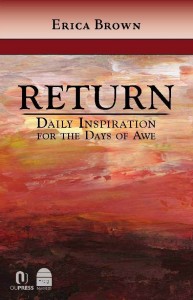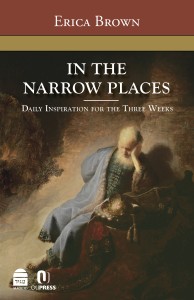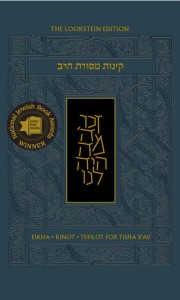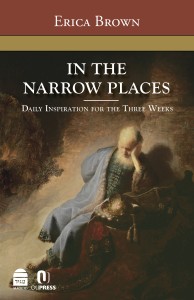Excerpted from Erica Brown’s Return: Daily Inspiration for the Days of Awe, co-published by OU Press and Maggid Books
Day Nine: Honesty
“For the sin we committed before You with verbal confession.”
We are always apologizing. New research contends that most of us apologize about four times a week. We say sorry all of the time. Reading the findings might lead us to believe that as people we are honest, generally contrite, humble, able to confront our mistakes and also take accountability for them – until you read further; we actually apologize 22 percent more to strangers than to romantic partners and family.
And, contrary to popular opinion, men will apologize just as often as women if they feel they’ve done something wrong. Therein lies the discrepancy. Women tend to believe that they’ve done something wrong more often than men. Women also tend to get offended more easily than men. This means that women both say they’re sorry and also need others to forgive them more often than men. In one study, 120 subjects imagined committing offenses, from being rude to a friend to inconveniencing another person they live with; researchers discovered that men apologized less frequently than women. The researchers concluded that men had a higher threshold for what they found offensive. “We don’t think that women are too sensitive or that men are insensitive,” says Karina Schumann, one of the study’s authors. “We just know that women are more sensitive.”
This new research on the act of saying sorry also deals with the content of apologies and what people need to hear in order to grant sincere forgiveness. A “comprehensive” apology is more likely to win forgiveness, researchers say. According to a study conducted by the University of Waterloo, comprehensive apologies consist of eight elements:
• Remorse
• Acceptance of responsibility
• Admission of wrongdoing
• Acknowledgment of harm
• Promise to behave better
• Request for forgiveness
• Offer of repair
• Explanation
If any piece of this process is absent, it could compromise the acceptance of an apology. Sorry alone is not enough. Sorry without regret or admission of wrongdoing will not change the future. We may think that most people who hear us apologize do not want an explanation. “Just say sorry. I don’t need to know why you did it.” But what we are learning is that sorry without an explanation can leave the recipient feeling empty and unsatisfied. Sometimes when people hurt us, even inadvertently, they become an enigma to us. It can be hard to understand how and why someone acts differently than we would, especially when it comes to shameful, hurtful, or offensive behavior.
For this reason, the act of confession forces us to be more honest with ourselves before we apologize. This season requires difficult self-confrontation. We read words that may or may not force us to revisit the darker sides of self in search of clarity or to rebuild a relationship. By externalizing the words in confession, we begin to hear them differently and get insight into how someone else might hear and receive our words of forgiveness.
The language of confession we use in our prayerbooks is excerpted in part from the book of Daniel. Daniel realized that his people were suffering and that he had failed to be as brutally honest as necessary in his leadership:
I turned my face to the Lord God, devoting myself to prayer and supplication, in fasting, in sackcloth and ashes. I prayed to the Lord my God, making confession thus: “O Lord, great and awesome God, who stays faithful to His covenant with those who love Him and keep His commandments! We have sinned; we have gone astray, we have acted wickedly; we have been rebellious and have deviated from Your commandments and Your rules, and have not obeyed Your servants the prophets who spoke in Your name to our kings, our officers, our fathers, and all the people of the land. (Daniel 9:3–6)
While the English may feel foreign, Daniel’s Hebrew is painfully familiar:
חטאנו ועוינו הרשענו ומרדנו; וסור ממצותך, וממשפטיך.
This is the language that jumps off the pages of the mahzor, our High Holiday prayerbook, and into our most vulnerable places. It is the language of confession, and it is thousands of years old. Maimonides writes that confession is an elemental aspect of repentance, and repentance cannot be complete without it. Why not?
Confession is another word for naming. Instead of a personal problem resting in the cloud of words not articulated, confession forces us to put a name on an issue. Often naming a problem creates a path out of the problem. Those struggling with addiction in one of its many forms often cannot confess to the problem. The minute they can finally name it, they can begin to solve it. Without a name, a problem will never be properly addressed. Without confession, there is no redemption. Rabbi Kook wrote that repentance actually begins the moment we commit a sin if we have an awareness of sin; the very recognition of an act of wrongdoing precipitates the beginning of teshuva, the road back to the self that is the emotionally and spiritually desired self.
Confession is a loaded English word that is not necessarily an accurate translation of the Hebrew word vidui. Naming, recognition, or acknowledgment may be more apt. In Deuteronomy, when Moses prepared the Israelites to enter the Promised Land, he told them that when they harvested their first fruits, they had to bring a basket of them to the Temple along with a verbal confession that begins with a brief history of our people. The history includes our most ancient ancestors, our servitude in Egypt, and the Exodus, and then finally our arrival in Israel and our new bounty. The food was to be left with God and then the person who brought it was to rejoice and “enjoy all the bounty that the Lord your God has bestowed upon you and your household” (26:11). This was a time of joy, not confession in its traditional, more oppressive sense. There is no confession of sin in this acknowledgment; merely a recognition, a naming, of all that has led up to this particular moment of gratitude. It is basket happiness – our joy is contained in something concrete that we are able to share with others.
The vidui bikurim, the name of this verbal offering, does review swaths of painful history. It mentions tribulations not worth repeating. And yet, each of those experiences must be mentioned because each went into the production and growth of every piece of fruit, as does every famine, rainfall, tragedy, and celebration. The pilgrimage would not have the same meaning, or the joy the same richness, if it all came easily. Confession helps us name all the parts of a process that lead up to a particular outcome.
Maimonides praised those who confessed in public, who had the courage to denounce personal wrongdoing to others. This was regarded as a higher level of commitment to teshuva precisely because exposing our weaknesses forces others to become witnesses to our transformation. But Maimonides also made a distinction between public confession of sins between human beings and sins between a person and God. In the latter category, he writes: “But sins between man and God should not be made public, and he is brazen-faced if he does so.” Public confession assumes a greater level of honesty unless it is about a public performance. No sincerity required. When confession acts as false piety it fails the lie detector test.
In his master work, On Repentance, Rabbi Joseph Soloveitchik pondered Maimonides’ distinction between God and fellow humans: “At times, a man may confess and declare his sins as a means of winning public approval, so that others will admire him and say, ‘what a righteous man he is!’…What the public thinks of him cannot matter when he stands ‘before God, blessed be He.’” If honesty is what we are ultimately seeking, then confession can be confession only if it provokes truth, not if it masks lies.
Facing the truth rather than masking a lie takes us to the bed of a virile King David, crippled by the news that the child born of his illicit relationship with Bathsheba was ill to the point of death. The chapter that relays the narrative begins with the ominous words: “But the Lord was displeased with what David had done” (ii Samuel 12:1). Nathan the prophet offered David a parable to help the king understand how wrong his affair with Bathsheba had been, a tale of sordid adultery, murder, and deception. Through the subtlety of Nathan’s parable, David was able to loosen his defenses and confess: “I stand guilty before the Lord” (12:13). David was able to hear Nathan because the prophet’s creative framework did not let David escape from confrontation with sin. Nathan added another dimension to his chastisement. He helped this confused king understand that he had overreached, that he had been blessed with so much that his greedy desire for this woman should have been curbed by his already overflowing bounty. Nathan expressed it as if from God’s very mouth:
It was I who anointed you king over Israel and it was I who rescued you from the hand of Saul. I gave you your master’s house and possession of your master’s wives; and I gave you the house of Israel and Judah and if that were not enough, I would give you twice as much. Why then have you flouted the command of the Lord and done what displeases Him? (12:7–9)
God gave David everything: power, prestige, and intelligence. Did David not have enough that he needed more, another man’s wife? Since David arranged for Uriah, Bathsheba’s husband, to be killed by the sword, he would suffer the sword’s ugliest wounds himself: “Therefore the sword shall never depart from your house…. I will make a calamity rise against you from within your own house” (12:10–11).
God’s words implied a military upheaval in the future, but God made no mention of the battlefield, the place of David’s many successes. David had approached Goliath with stones; his physical strength and military acumen were well-known by this point in his story. The battles David could not win were those that touched his own home life.
Nathan pronounced the punishment: “The child about to be born to you shall die” (12:14). After Nathan left the royal palace, the child became critically ill. David prayed and fasted. His servants tried to feed him, but he refused. A week after Nathan left, the child died, but David’s servants were too afraid to tell him. Since David had not listened to their adjurations to eat, they were certain he would not accept the bad news, that he would do something terrible. They were wrong. David saw the servants speaking in whispers to each other and then he understood what had happened. He forced them to be honest:
“Is the child dead?”
“Yes.”
We hear the anguish of the question and the anguish of the answer. There was no room for grey. Honesty stood starkly and painfully alone.
David washed and changed his clothes, went to pray, and then asked for a meal. The servants were again confused. How was it that their king rejected all food when this infant was sick but once the child died, he was able to eat? David responded with clarity. When the child was ill, perhaps there was still some small hope for compassion. But once the boy was dead, David knew that he had to face the brutal truth: “Now that the child is dead, why should I fast? Can I bring him back again? I shall go to him, but he shall never come back to me” (12:23).
The truth hurts. It hurts more than any lie we could tell ourselves. But the truth is not going away.
King Solomon saw this stubborn tendency when he finished building the First Temple and contemplated whether or not God could ever be limited to any space. King Solomon understood the function that the building might one day have far into the future, describing life not in the land of Israel but in the Diaspora at the hand of enemies. The Temple would then have a different function; it would become a holy space, only aspirational in nature, precisely because the pattern of sin and forgiveness is predictable:
When they sin against You – for there is no man who does not sin – and You are angry with them and deliver them to the enemy, and their captors carry them off to an enemy land, near or far, and they take it to heart in the land to which they have been carried off, and they repent and make supplication to You in the land of their captors, saying: “We have sinned, we have acted perversely, we have acted wickedly,” and they turn back to You with all their heart and soul, in the land of the enemies who have carried them off, and they pray to You in the direction of their land which You gave to their fathers, of the city which You have chosen, and of the house which I have built to Your name – give heed in Your heavenly abode to their prayer and supplication, uphold their cause, and pardon Your people who have sinned against You for all the transgressions that they have committed against You. Grant them mercy. (I Kings 8:46–50)
We turn our hearts away. We sin. We suffer. We turn our hearts towards. God hears. God redeems. We turn our hearts away…. King Solomon offers an ancient theological equivalent of “lather, rinse, repeat.” It happened before. It will happen again. And again.
As a result, we often hear an apology and judge it as insincere or simply false. It does not sound like the truth. After all, we apologize for a lot of reasons that have nothing to do with the truth: to get out of trouble, because it is expected, to end an argument, out of politeness, to repair a relationship, to move on. These are all valid reasons but are not honest responses; when we apologize for any of these reasons, we are not necessarily engaging in a serious reckoning on a specific problem. Just watch the way people ask for forgiveness in Jewish settings about this time of the year. I distinctly remember in high school the day before Yom Kippur, we would walk down the halls asking anyone and everyone for mehila, for forgiveness, with spitfire speed but with hardly a moment for any authentic response. We never anticipated someone turning around and saying, “Actually, you really hurt me this past year.” We waited for the hasty “yes” and for the question to be reciprocated at a fast enough pace to allow us to move on to someone else. The apology is regarded as the formal pass that lets us continue or progress. It’s not about process; it’s about a shallow fulfillment of a legal requirement. It’s not about truth; it’s about peace.









